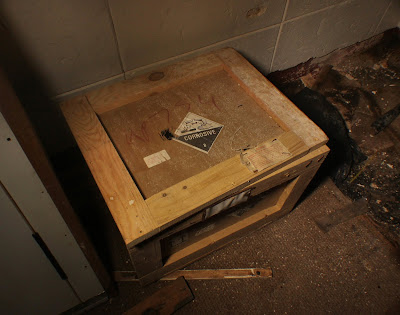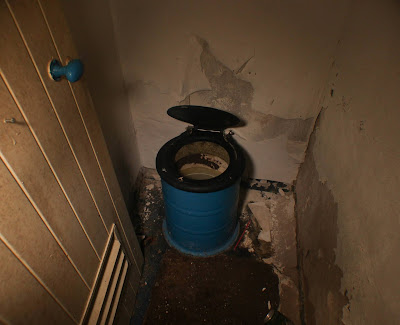(Disclaimer: Joking aside, I fully understand the risks/dangers involved in these adventures and do so in the full knowledge of what could happen. I don't encourage or condone and I accept no responsibility for anyone else following in my footsteps. Under UK law, trespass without force is a civil offence. I never break into a place, I never photograph a place that is currently occupied, as this would be morally wrong and intrusive, I never take any items and I never cause any damage, as such no criminal offences have been committed in the making of this blog. I will not disclose location or means of entry. I leave the building as I find it and only enter to take photographs for my own pleasure and to document the building.
Recently I met up with my awesome cohort and chum, Jess, for a long overdue reunion. She's been overshadowing me completely by going to Indonesia and making friends with monkeys. I'm very jealous. I've been stuck here making friends with the monkeys less-intelligent cousin, humans. But Jess and I are teaming up again for a myriad of new adventures, starting with yet another nuclear monitoring bunker quietly tucked away in the countryside.
I love these things. So many people pass them every single day and never realise what's there, or what historic significance it holds. But for those of us who recognise the surface features, they're very appealing.
If you're a long time reader of this blog, you'll have seen one of these before, seeing as I've been to about thirty of them now. That sounds like a lot, but when one considers that there were 1,563 of them built across the UK, then that's actually less than 2%. It might seem bleak but it's not anything I'm too bothered about.
While these were all built identical, the varying histories of each post have given them a flavour of uniqueness. Due to reorganisation, many closed in 1968. Those ones tend to be in the worst condition, having endured half a century of dereliction and visits from urban explorers and cold war enthusiasts. I know a lot of people think urban exploring and the internet coincide, but I've seen enough historic graffiti to know that people were urban exploring decades before the internet existed. To suggest otherwise is like saying the 1936 Olympics were the first ever sport event, because none had been on TV before that. As long as humans have been adventurous, free spirited and simultaneously careless about what they leave behind, this sport has existed.
After the closure of more than half of the bunkers in 1968, the ones that were left ultimately closed in 1991, with the fall of the soviet union. Most of them are locked and forgotten. Some are demolished. Some are even renovated and put to use as wine cellars and man caves. Any that are left open tend to be trashed. And all of this is why I never travel out specifically for them. They're simply too much of a gamble. Traveling out just for one could ultimately lead to disappointment so instead I just pop by if I happen to be in the area, and sometimes I get lucky. This is one of those times.
This bunker was decommissioned in 1991, which means it has a better chance of being in good condition than many others. But even so, the only entrance is still a solitary fourteen foot ladder into nothingness that hasn't been maintained in about three decades. Only a fool would venture in.
Whoopsie!
Interestingly there are still triangular marks behind the ladder, and on the hatch, where signs used to adhere to the walls warning people to watch their heads and backs while climbing the ladder. Someone has clearly taken them away.
For those who don't know, these nuclear monitoring bunkers are commonly referred to as ROC posts, due to being manned by the Royal Observer Corps during the Cold War. The Cold War didn't involve any actual fighting. Its name just refers more to an era of escalating tension. Nobody really wanted to blow up the planet in a nuclear armageddon, but the fact that two opposing sides had nuclear weapons was cause for concern. The purpose of the ROC posts were to monitor for nuclear activity and communicate their findings.
This post was built in 1965, and would have contained various communication and monitoring equipment. There were also living arrangements such as beds, and rations, so that people could essentially live down here and be safe if there was a nuclear strike.
Numerous diagrams exist online to detail how they would have looked:
There are variations in internal layout. Some have a third bed across the length of the main room, and when the first prototype was built in 1956, four people were actually sealed inside with rations and bedding. After this initial trial run, only some very minor changes were actually made to the prototype going forward, and they were mostly concerning ventilation. I guess someone pointed out that people require an oxygen supply to survive underground
As you can see, these bunkers are tiny! There's the main room, and then just opposite the ladder there's a cupboard with a toilet in it. I can't imagine how I'd cope if I had to stay here with multiple people for any period of time. I'd probably go a little nuts. I guess the complete lack of personal space is a small sacrifice for not getting blown up, but if I seriously consider my three most annoying work colleagues and imagine living with them in this space, nuclear annihilation sounds rather preferable.
Anyway, let's see what we've got.
To my absolute delight, this bunker is actually in pretty good condition. It's a little cluttered, but this mess is a little vintage wasteland of artifacts.
There's this little frame on the door which presumably would have held the visitors book. Anyone coming around to the bunker who wasn't the every day personnel would have had to sign in and out. Usually in buildings the guest book is a health and safety precaution so that if there was a fire or something, they can monitor who is actually in the premises so that nobody gets unknowingly trapped inside, or so that the firefighters don't waste time searching for someone who has already left.
I'm not sure why you'd need something like this in a structure like a ROC bunker. It's not as if anyone can go unnoticed.
There's also a sticker on the door for the Chirk air cadets. We're quite the trek away from Chirk, but I guess they used the bunker for their activities at some point. The Chirk air cadets began as a branch of the Wrexham air cadets until becoming their own separate entity in 1986. Given that this was in the final few years of the ROC using the bunker, it makes sense that they were allowed to use it.
On the wall, we have the last remnants of the telecommunications equipment.
Old cooking equipment.
And check this out! Next to an old roll of sellotape, there's a hand-written note telling someone, presumably the Royal Observer Corps, that they may now stand down. This could be one of the final communicatios that this post recieved before it closed. I would have expected it to be on a more formal sheet of paper, which makes me wonder if it's not for something else altogether. But I can't make out the font on the top of the note.
This box, used to carry and store batterys, says "Packaged: May 1961."
Here's a vintage dustpan.
Here's an envelope that once had a load of "mini" exercises for the folks stationed here to do in 1990.
This is pretty cool! It's a vintage first aid box.
At the far end of the bunker, there weren't any bed frames, but the mattresses were still here, still wrapped in plastic. I guess they never got around to actually staying in this place.
The cupboard has a little torch holster and battery shelf.
This is the closeable air vent at the back of the bunker.
Here's a wine box. I guess waiting for an armageddon that never shows up does build up a healthy thirst.
Finally, it's the best part of any abandoned place, the toilet.
Rather than have an actual toilet with a flush mechanism, the Royal Observer Corps, for their bravery, were awarded a bucket with a seat. If you thought these were cramped living conditions already, imagine having to stay down here if one of your colleagues had the shits. Someone also had to lug this up the ladder to empty it out after use, too. It doesn't sound pleasant.
But it's still in better condition than the toilets in some pubs and clubs.
Anyway, that's all I've got today. ROC bunkers don't make for big blog posts, but they are cute, and they are unappreciated. This thing served a purpose for several decades. Sure, the cold war never escalated to the point that these bunkers were really put to the test, but nevertheless the work done here was integral to security in an uneasy time, and these places deserve more than to be just forgotten in a field.
My next blog post will be a bit bigger as I take an in-depth look into a huge underground military complex and then I'm blogging about a huge abandoned mill with a spectacular view from the roof!
In the meantime, follow me on Instagram, follow me on Reddit, like my Facebook and follow me on Twitter.
Thanks for reading!



























No comments:
Post a Comment